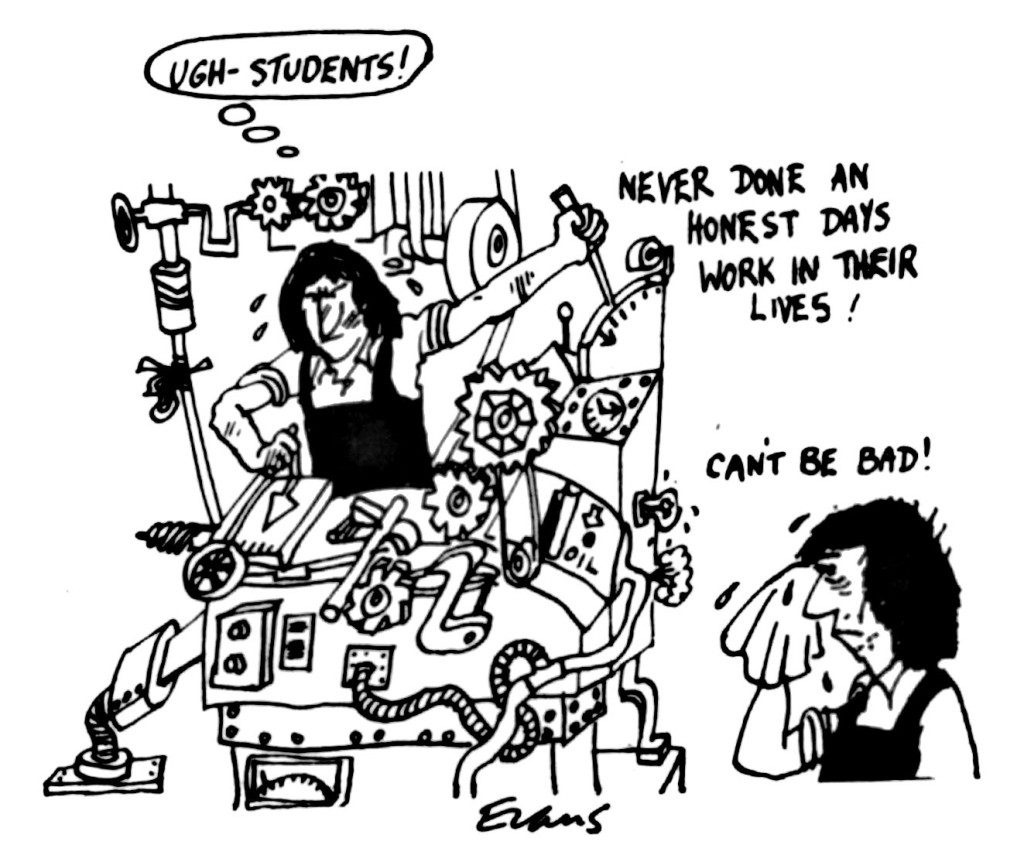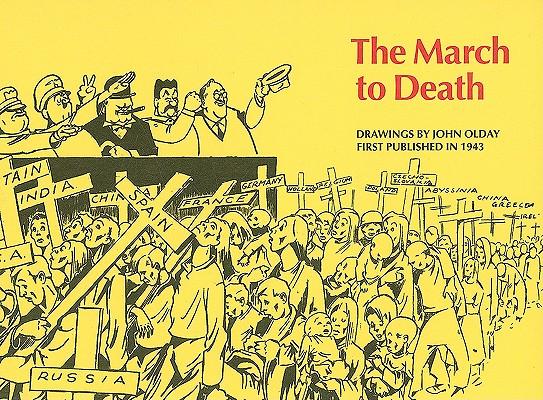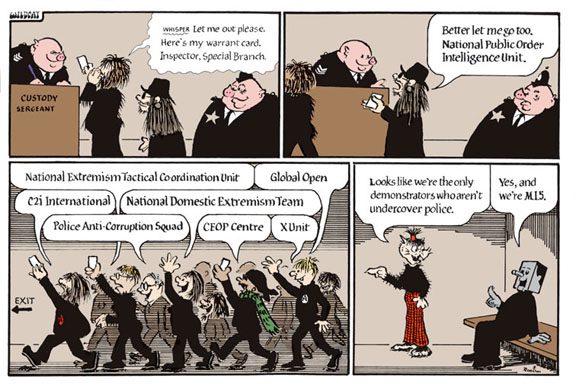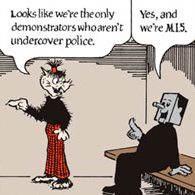The New York Comics & Picture-Story Symposium is a weekly forum for discussing the tradition and future of text/image work. Open to the public, it meets Tuesday nights 7-9 p.m. EST in New York City. Presentations vary weekly and include everything from historical topics and technical demonstrations to creators presenting their work. Check out upcoming meetings here.
***
The 117th meeting of the New York Comics & Picture-Story Symposium was held on Tuesday, March 10th, 2015. Kent Worcester presented “Ten Great Cartoonists You’ve Never Heard Of,” a survey of 20th century left-wing short-form cartoonists.
Worcester opened with an apology regarding the title of his talk. Instead of “Ten Great Cartoonists You’ve Never Heard Of,” he suggested that “Ten Good-to-Great Cartoonists You May Have Heard Of” might be more accurate. However obscure, the sampling he offered made for a lively and insightful presentation of left-wing short-form political cartoons from the 20th century, published by Communists, Trotskyites, Proletarians, and the other political strains that competed vigorously for the conscience of the American worker.
Worcester has his academic background in political science, and a strong familiarity with comics, but he’d kept his two interests separate until one day in 2004 when he found himself at the editorial board meeting of a political science journal in Washington, DC, trying to decide on a topic for a print symposium. His inner voice said, “Don’t mention comics! Don’t mention comics!” But of course, he mentioned comics, and the managing editor, to his surprise, decided that it was a great idea, and contributions on the topic followed.
Worcester is not entirely happy with the way comics studies have developed in the United States. He finds an overabundance of Scott McCloud’s (Understanding Comics) influence, which covers long-form self-expressive comics, typified by American and French graphic novels, but not short-form comics. “We need to movie past McCloud’s blinders,” he says. Juxtapositions, sequences, and panel-to-panel transitions matter,  but so do concision and encapsulation. Graphic novels are important, but so too are magazine and newspaper single panel cartoons.
but so do concision and encapsulation. Graphic novels are important, but so too are magazine and newspaper single panel cartoons.
To illustrate, Worcester passed out copies of the Special Cartoon Issue of Private Eye, a British humor magazine, which he rates alongside Charlie Hebdo, WW3 Illustrated, and The Onion as one of the great satirical publications of our day, and which continues the traditions of the cartoonists he presented to us.
Here is Worcester’s roster of “Ten Good-to-Great Cartoonists You May Have Heard Of”:
M. Vern Breitmayer (1889-1966) ran for a House seat in Michigan as an anti-war socialist. He joined the Proletarian Party, a left-wing rival to the Communist Party, and drew for their paper, The Labor Digest. Like many of his generation, Breitmayer aspired to be a painter and cartooned reluctantly. In fact, the Proletarian Party itself was staunchly against popular culture—”for the workers it is deadly poison!” was one of their declarations.
John Olday (1905-1977) was born in London as Arthur William Oldag, took part in the German revolt in 1918, and, as a Spartakist, spied on the nascent National Socialist Party (among other things, he was bisexual, and would gather intelligence by sleeping with gay Nazis). In 1938, he fled to Britain and undertook anti-Nazi causes. Olday joined the Royal Pioneer Corps, but deserted in 1943, and spent three months in prison before being freed by a campaign involving George Orwell. He migrated to Australia in 1950, and his cartoons regularly appeared in War Commentary, then irregularly in Freedom in the late 40s to early 60s. He authored The March to Death, published by Freedom Press, and returned to London in the late 60s to help the anarchist cause.
Laura Slobe (1909-1958) was born in Pittsburgh, studied at the Art Institute of Chicago, and worked for the WPA (though most of the public art she did wound up being destroyed by the government). A celebrated sculptor whose work reflected her Trotskyite views, she joined the Socialist Workers Party (her party name was “Gray”), and executed over 400 cartoons for the party’s organ, The Millitant, while she also held down jobs as a window dresser for Macy’s and Bloomingdales. Later on, she drew about civil rights issues for black papers, and in particular, about the events in Montgomery. The SWP fortunately kept all Slobe’s drawings and donated them to NYU, where they are now preserved as a collection. There’s also a sculpture award given in her name at the Art Institute of Chicago.
Jesse Cohen (1909-1979), also known also as “Carlo,” was born in New York City, studied at the League, and drew for the Boston Evening Transcript and New York Herald Tribune, with which he helped support his family during the Depression. He drew for the pro-Trotsky, anti-Stalin Labor Action and Socialist Appeal. Bitterly opposed to Stalin, Cohen received a letter from Trotsky himself which praised his efforts and classed him with Diego Rivera, calling him “a magnificent artist” and “a  genuine revolutionary.” Irving Howe, who edited Labor Action, remembered him as “our charming, feckless artist” and for his bold lines and chiaroscuro (Worcester compares him to Syd Hoff). Cohen created over 200 images for Labor Action, and eventually turned to abstract painting. He appeared as a character in Harvey Swados’s 1970 novel Standing Fast.
genuine revolutionary.” Irving Howe, who edited Labor Action, remembered him as “our charming, feckless artist” and for his bold lines and chiaroscuro (Worcester compares him to Syd Hoff). Cohen created over 200 images for Labor Action, and eventually turned to abstract painting. He appeared as a character in Harvey Swados’s 1970 novel Standing Fast.
It should be clear by now that the ideological differences between various the left-wing parties were so pronounced that each camp saw the others as enemies. Political differences may even have kept some of these cartoonists from meeting or knowing each other, even those who lived close by in lower Manhattan.
Ben Yomen Miller (1911-2011), known as Ben Yeoman, was a Michigan born, Ann Arbor-based pro-labor member of what became known as the Popular Front. His work appeared in hundreds of pro-labor newspapers and magazines as well as The Detroit Free Press and Ebony. He created the “Congressman Drip” strip and is known for a single-panel editorial cartoon depicting a woman in the role of Eve, labeled as the “American People,” with Governor Thomas E. Dewey serving her an apple of his political agenda. It was the first time that a woman was cast as the American People in any known political cartoon.
Jimmy Friell (1912-1997) was a Scottish cartoonist who drew for The Daily Worker from 1936 to 1957. His party name was “Gabriel,” which he chose to herald the end of capitalism. He walked out of the Party after Khruschev’s revelations about Stalin. “I couldn’t conceive carrying on cartooning about the evils of capitalism and imperialism, and ignore the acknowledged evils of Russian Communism.” He also drew about the Rosenbergs (“Hysteria”) and was part of a left-wing movement after WWII to oust America and her influence from Great Britain. He ended up drawing cartoons for the Evening Standard.
Pele deLappe (1916-2007) was raised in San Francisco and made her life’s work the depicting of images of working class people and social realism. She did a series of paintings about the San Francisco Maritime Strike of 1934, was an editor for People’s World, the San Francisco sister publication to The Daily Worker, and contributed drawings to The Chronicle. She numbered among her friends Frida Kahlo and Jelly Roll Morton.
Donald Rooum (1928-) has been interviewed by Kent Worcester for The Comics Journal. He had a career as a typographer at various ad agencies, and then lectured in typographic design at the London College of Printing. Seven collections of his “Wildcat” cartoons have been published, and he has drawn for the Daily Mirror, The Skeptic, and The Spectator. He’s also been a frequent orator at Speaker’s Corner in London. A self-described “Stirnerite anarchist,”  he has observed, over the years, “less deference to the royals, a greater tolerance of gays,” and no clear judgment over the ultimate fate of the Soviet Union.
he has observed, over the years, “less deference to the royals, a greater tolerance of gays,” and no clear judgment over the ultimate fate of the Soviet Union.
Phil Evans (1946-2014) is Worcester’s personal favorite of the cartoonists he presented. Born into an academic British family, he became active in the Youth Campaign for Nuclear Disarmament, and began drawing political cartoons as a result of his opposition to the Vietnam War. He has contributed work to the Socialist Worker and other International Socialist papers. In his introduction to The Joke Works, he reported that he started out wanting to be a painter, but found cartooning to be a more immediate challenge: “A little pamphlet with cartoons on the struggle of a tiny group of seamen against their union leader is more important than the cracks on the face of an important diplomat or princess.”
Charles Peattie (1958), a London-based cartoonist who studied at St. Martin’s School of Art, is best known for his comic strip “Alex” with Russel Taylor, and “Celeb,” featuring Gary Bloke and Pixie Frou-Frou.
Worcester’s survey would of course be incomplete without Friedrich Engels (1820-1895), who was in the game early on. It’s not widely known, but he was drawing and publishing cartoons some twenty years before he and Marx created The Communist Manifesto.
The one cartoonist Worcester celebrates on the opposite end of the spectrum—a member of the Libertarian school—is Peter Bagge. Conversations with Peter Bagge is Kent Worcester’s latest book, and merits a discussion all its own.
***
Image credits:
1. Phil Evans on the plight of the worker. (Source: The Comics Journal)
2. March to Death, compiled drawings by John Olday. (Out of print. Source: booktopia.com)
3. Donald Rooum, from Wildcat Keeps Going, © 2012 Freedom Press.
***
Kent Worcester is a Professor of Political Science at Marymount Manhattan College. He studied Economics and Political Science as an undergraduate at the University of Massachusetts at Boston and received his Ph.D. in Political Science from Columbia University. He is the author, editor, or coeditor of eight books. His recent publications include “Jesse Cohen, Laura Slobe, and the Hidden History of Political Cartooning” (with Ethan Young; International Journal of Comic Art, 2013); “New York City, 9/11 and Comics” (Radical History Review, 2011); and “The Punisher and the Politics of Retributive Justice” (Law Text Culture, 2012) Professor Worcester joined the MMC faculty in 1997. He teaches courses on democratic theory, international relations, green political theory, modern political theory, and Plato’s Republic.
***
About the author: Mark Lerer holds a bachelor’s degree from Princeton University and an MFA from the New York Academy of Art. He has been the Art Director of Street News, and published a study of Will Eisner for the Museum of Comic and Cartoon Art. His cartoon drawings have been run in the New York Post, appeared at New Century Artists and Nexus galleries, and are regularly featured on Facebook.





One response
Yay for Wildcat! Yay for Donald Rooum! Wildcat is sometimes published in the anarchist magazine, The Match, whose publisher, Fred Woodworth, would make for one hell of an interview, assuming any interviewer would be able to get him to consent to one.
Click here to subscribe today and leave your comment.